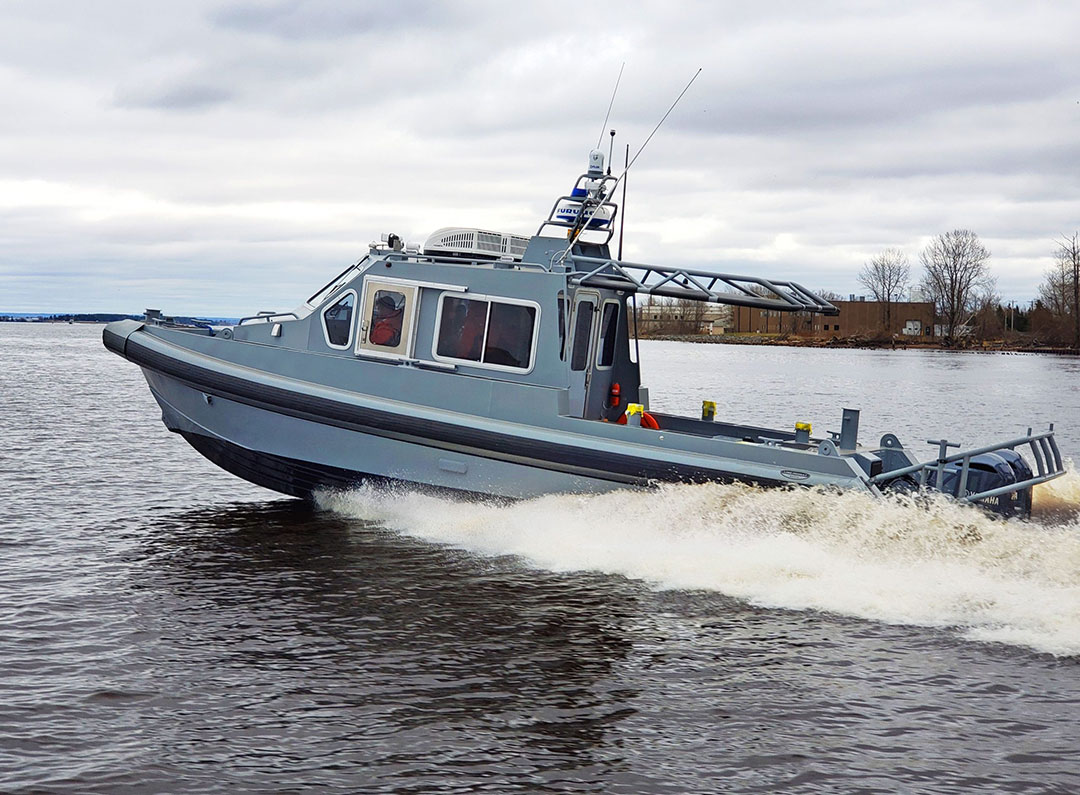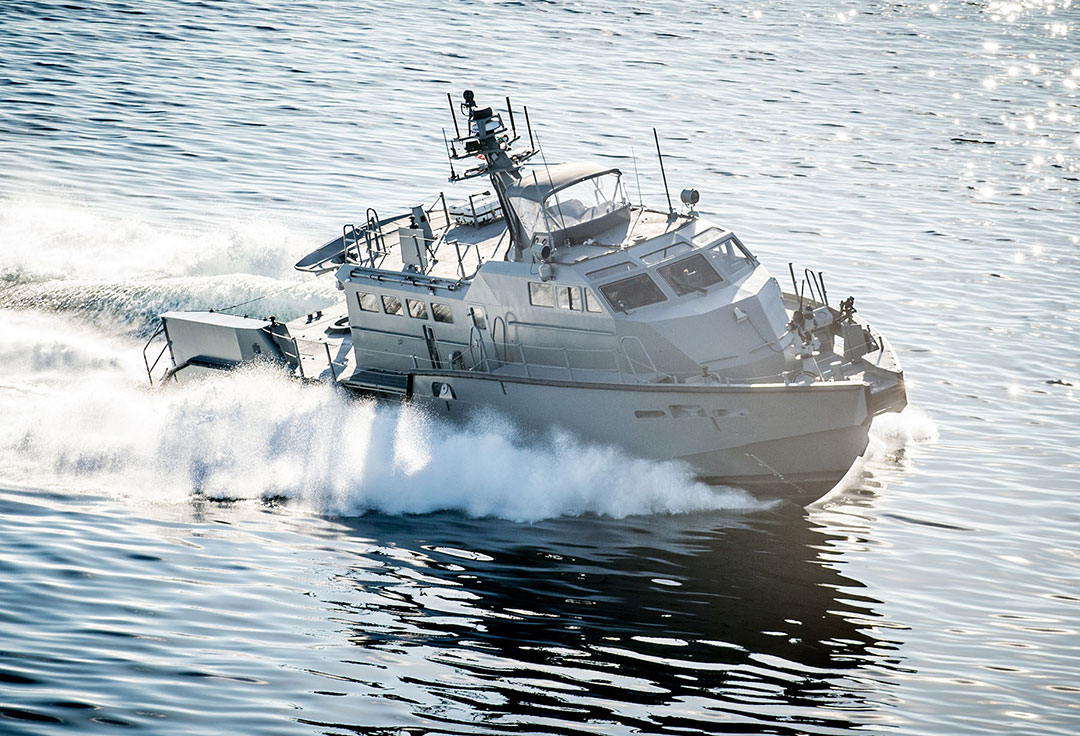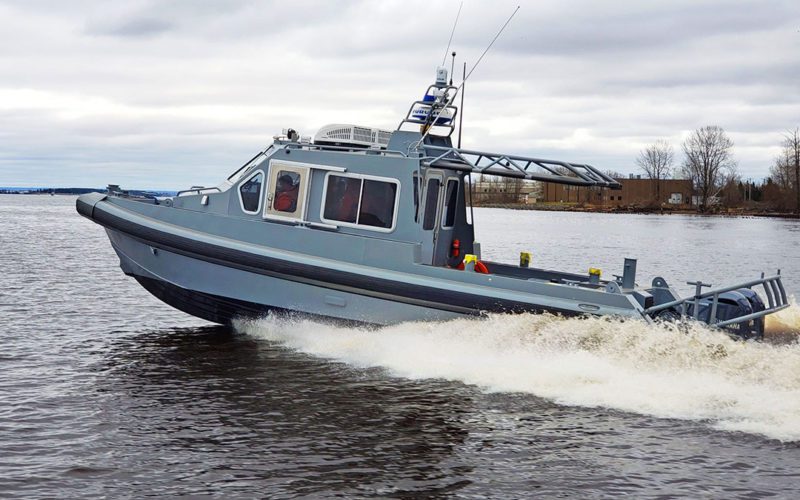
The United States Navy operates some of the most advanced, most capable warships in the world. And when those vessels are in port, the service relies on a force of smaller crafts to keep its ships, sailors and installations safe.
That’s the concept behind the Force Protection-Medium (FP-M) patrol boats currently under construction at Lake Assault Boats in Superior, Wis. As of early April, the shipyard had delivered seven of the 33-foot aluminum craft from an order that could grow to 119 vessels and $56 million over five years.
“These boats are being deployed for fleet force protection, maritime interdiction, law enforcement operations at Naval activities and adjacent ports and waterways duties,” said Jamie Koehler, a spokesperson with Naval Sea Systems Command. “These boats are replacing like vessels that are beyond their service life and beyond economical repair.”
Lake Assault Boats, located acres across St. Louis Bay from Duluth, Minn., developed the FP-M design to meet and exceed Navy specs, according to Jim Sorenson, the shipyard’s regional sales manager.
“We tried to make more room in the cabin,” he said of the design process. “There is a head and shock-mitigating seating — there is just a lot of stuff put into a small boat and we tried to maximize space as much as possible.”
Each vessel has a V-hull design with a 10-foot beam, as well as a fully enclosed climate-controlled cabin. The hull is wrapped with a Wing polyurethane foam collar. Its navigation and safety equipment includes Furuno radar and a FLIR thermal imaging camera. Propulsion comes from twin 225-hp Yamaha outboard engines capable of pushing the vessel beyond 35 mph.
Despite its relatively small size, the FP-M packs plenty of firepower. Each vessel has four weapon mounts each capable of accommodating up to .50-caliber machine guns.
The contract represents the first major military order for Lake Assault, which has hired new personnel and dedicated a corner of its 60-acre shipyard to build the vessels. Its current capacity allows for one delivery a month, Sorenson said. As of April 4, the Navy has exercised orders for 28 vessels.
“It has meant a great deal,” Sorenson said of the Navy contract. “This is a market Lake Assault has never been in before.”
Lake Assault isn’t the only shipyard, of course, winning contracts for military patrol boats. In October 2021, Silver Ships of Theodore, Ala., announced a contract with Naval Sea Systems Command for the delivery of 110 Naval Special Warfare (NSW) Surface Support Craft (SSC) and U.S. Coast Guard Special Purpose Craft, Law Enforcement (SPC-LE) vessels. The order could be worth $51.6 million over five years if fully exercised.
“We are very proud to help contribute to the readiness of our nation’s NSW and Coast Guard forces,” Shawn Lobree, federal contracts manager for Silver Ships and a retired Navy captain, said in a news release. “Quality, customer service and teamwork are very important to us, and we look forward to working with Navy and Coast Guard teams to build and deliver the five variants.”
The NSW vessels have an aluminum hull with a deep-V design and come in 8- and 11-meter lengths. Some will have an open center console and others will have an enclosed cabin. The SSC vessels will be used in numerous missions, including diver and swimmer support, medical transport, vessel towing and water airdrop training, according to Silver Ships.
The 11-meter vessels built for the Coast Guard will operate along U.S. borders and in the Caribbean Sea, the shipyard said. They are armed and capable of intercepting suspicious vessels. All five vessel types will be powered by outboard engines.

On the West Coast, SAFE Boats International of Bremerton, Wash., announced a contract modification last fall for construction, outfitting and training of six Mk VI patrol boats for Ukraine, with options for two more. The vessels will be provided via a State Department-approved agreement utilizing Building Partner Capacity and Foreign Military Financing money.
The 85-foot vessels will be powered by twin 2,600-hp MTU 16V 2000 engines paired with HamiltonJet waterjets. Each Mk VI patrol boat has a range of more than 600 nautical miles with a sprint speed exceeding 35 knots.
SAFE Boats hired about 75 people to work on the Ukraine-bound vessels, most based at the company’s Tacoma facility. The five-year contract will be completed by March 2025 or March 2026, depending if the two additional orders are made. The total contract value exceeds $89 million.
Additional details on the vessels were not available, including delivery timetables for individual vessels. SAFE Boats declined to comment on the project given the sensitive nature of the vessels and the security work they will perform in Ukraine.

While these shipyards are building patrol boats that will be crewed by military personnel, Metal Shark is developing a series of autonomous vessels for the U.S. Marine Corps.
Long Range Unmanned Surface Vessel System (LRUSV) vessels are a fully autonomous, AI-driven, unmanned fleet, with the ability to be optionally manned or operated remotely, said Josh Stickles, Metal Shark’s executive vice president.
They have extended ranges and will be controlled by personnel on shore through technology developed by Spatial Integrated Systems. Metal Shark also will build manned support craft based on its 40 Defiant platform that the Navy is using for its new 40 PB patrol boat fleet.
All told, Metal Shark has designed, built and delivered more than 400 autonomous and remotely controlled vessels, with more to come under current contracts. The company has partnered with Sea Machines, of Boston, on other autonomous vessel projects.
“The LRUSV program represents a significant milestone for autonomous technology, for the defense world, and for the entire shipbuilding industry,” Metal Shark CEO Chris Allard said last year when the contract was announced.
“As we develop and deploy the LRUSV system for the Marine Corps,” he continued, “we will continue to work with clients across government and commercial markets, integrating the systems of multiple technology partners into our boats … and streamlining the path to autonomy.” •

